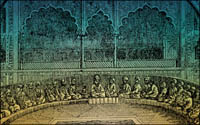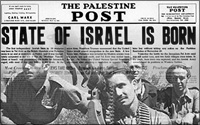 The Men of the Great Assembly passed decrees that ensured the Jewish peoples’ survival in the post-Temple era down to our times.
The Men of the Great Assembly passed decrees that ensured the Jewish peoples’ survival in the post-Temple era down to our times.
At a time when Jewish life in the Land of Israel was crumbling, Ezra and Nehemiah swept in like a whirlwind. They not only closed the breaches in the physical walls of Jerusalem, built the Second Temple and set the foundation for the Second Commonwealth (the Second Temple era), but set the spiritual foundation and built the spiritual walls of the nation for the foreseeable future lasting to this day.
The primary vehicle through which they accomplished this was the establishment of an executive and legislative body called the Anshei Knesset HaGedolah, the “Men of the Great Assembly,” which was composed of the 120 greatest leaders, some of whom were prophets, including Ezra, Nehemiah, Mordechai, Zerubbabal, Haggai, Zechariah and Malachi. The modern day Israeli Knesset (Knesset is the Hebrew word for “Assembly”), which has 120 members, took its name and number from them. Unfortunately, that is where the comparison ends.
Their primary task was to smooth the transition into the new era by passing legislation that would insure the survival of the Jewish people.
Among the most important measures were:
- Sealing the Scriptures
- Instituting prayer
- Coordinating the Jewish calendar
- Establishing an educational system in the land of Israel.
All told, the Men of the Great Assembly spanned no more than a generation. Yet, the reverberations of their decisions are still felt today. By studying their decrees we gain entrance to a glimpse not only of their role in Jewish history but of the primary ingredients needed for Jewish survival.
Sealing the Biblical Canon
Their first major decision was to seal the Bible; to decide which books to include in the Holy Scriptures. Prophecy had ceased in the Second Temple era (Talmud, Sotah 48b). No longer could anyone claim to have an open line, as it were, with God. Therefore, without prophecy there was no possibility of divine inspiration to warrant admittance of anyone’s words into the Bible.
One reason this was important was because later groups like the Christians felt it necessary to include certain books which are not included in the Jewish reckoning. These books, they wanted to believe, bridged the gap to the Christian Gospels, a gap for all intents and purposes closed centuries beforehand with the decree to seal the Bible.
In all, the Men of the Great Assembly included 24 books in the counting. Afterward, no more books could be added. As the central body of the greatest Jewish sages and scholars their authority to do so was never disputed.
Prayer
The second monumental accomplishment of the Men of the Great Assembly was the formulation of a universal Jewish prayer service.
Today, the centerpiece of every service is the prayer known as the Amidah (literally the “standing” prayer ). It and its attendant prayers were apparently absent in the First Temple era. The need for such a formalized prayer only first arose when the Jews went into exile in Babylon. The missing experience of community that went part and parcel with the three-times-a-year pilgrimage to the Temple left a vacuum. Without the Temple, essential nutrients in the peoples’ religious diet were lacking. Therefore, the leaders in Babylon codified a system of prayer that substituted the Temple service. They based this on the prophetic verse, “Our lips will substitute for sacrifices” (Hosea 14:3).
When the Jews returned from Babylon to the Land of Israel and rebuilt the Temple they brought along with them the prayers they had learned in Babylon. The Men of the Great Assembly ordered, edited, and formulated the words of the Amidah, as well as its surrounding prayers. This arrangement continued through the entire Second Temple era and remains today.
Although the individual synagogue system was inferior, it successfully compensated for the shift in Jewish life away from the centralized Temple system. Now, with the stamp of approval from the Men of the Great Assembly, Jewish prayer became possible in each community, in each individual, no matter how far away he/she was. Instituting prayer this way not only substituted for the Temple service but compensated for the loss of center in Jewish life.
The Calendar
Their third major accomplishment was the development of the permanent calendar.
When the communists came to power in Russia in 1917 they banned the Jewish calendar even before they banned the prayer-book. They realized that without knowing the precise dates of the Jewish holy days no Jew could possibly maintain his religion. If one Jew thought Yom Kippur was Wednesday and one thought it was Thursday and another thought Friday the structure of Jewish life would collapse. Therefore, they banned the calendar first.
The Jewish calendar is based on the cycle of the moon. However, if it were a strict lunar calendar then every year would be 11¼ days less than the solar year. The problem then would be that in three years an entire month would be lost. In six years, two months would be lost. And so forth. Eventually, a holiday like Passover would come out in the dead of winter… and then fall… and then summer… and then spring again.
In fact, this is precisely the situation with the Muslim calendar, which is entirely lunar. After a period of time their holidays traverse the entire year. The Torah, however, expressly commands that Passover fall out in the springtime (Exodus 23:15, 34:18; Deuteronomy 16:1), which refers the vernal equinox.
Therefore, the Jewish sages added a leap month to the Jewish year. The solar and lunar years line up exactly every 19 years. Therefore, seven times every nineteen years an entire month is added.
Not only were the Jewish leaders great Torah scholars but they had great knowledge in astronomy, mathematics as well as other “secular” disciplines. Among the proofs of their intellectual acuity are the mathematical calculations they made back then for determining the exact moment of the lunar month. The Talmud (Rosh Hashanah 25a) tells us that, based on those calculations and a tradition going back to Sinai, Jewish months are calculated at 29.53059 days. Only first with the advent of modern technology — solar satellites, hairline telescopes, laser beams and super-computers — were NASA scientists able to determine the length of the “synodic month,” i.e. the time between one new moon and the next. And that figure is 29.530588 days.[1]
The basis for the permanent calendar was laid by the Men of the Great Assembly. They perfected all of the mathematical adjustments and intricacies that make the Jewish calendar laser-beam accurate even by today’s standards — a truly remarkable feat.
Raise Many Students
The fourth accomplished of the Men of the Great Assembly was the establishment of an educational system in the Land of Israel.
From time immemorial, Jewish survival has always depended on knowledgeable Jews. As we mentioned previously, the settlers who originally returned with Ezra and Nehemiah were not the elite of the Jewish people. Consequently, the educational system was at best mediocre. It was the task of the Men of the Great Assembly to revamp and revitalize it.
The problem they faced was not only building raising funds, schools and attracting students. Israel had lost credibility as the Torah center for world Jewry. It was surrounded by enemies and economically unstable. They, therefore, mounted a campaign to reestablish Israel, and specifically Jerusalem, as the central address of the Jewish people.
One of the first things that they did toward that end was reestablish the Sanhedrin, the central body of Torah authority. Once operational again they let it be known that all important questions of Jewish law should be sent to Jerusalem.
Ancient documents discovered about a century ago bear out how well this strategy worked. The documents referred became known as the Elephantine Papyri. The papyrus parchments were made from reeds grown along the shores of the Nile. They were written by the members of a garrison of Jewish mercenaries stationed near what is today the Aswan Dam. The Greeks called it Elephantine because they transported elephants to and from there.
This group consisted of about 150 soldiers, along with their families, who were on permanent station in Elephantine. It is mind boggling. Elephantine was the end of the world at that time. These 150 Jews were hired to collect customs duties for the Persian Empire and prevent marauding African tribes from entering Egypt. Some job for a nice Jewish boy!
The Elephantine Jews knew they were Jews, but little else. They wrote a letter to the High Priest in Jerusalem, asking him basic questions such as what day of the year was Rosh Hashanah, where do they get matzos (unleavened bread) for Passover, how do they make them, how do they build a mikvah (bath for ritual immersion), which way was the synagogue supposed to face, etc. In essence, the letter said, “Make us Jews; we want to be Jews; help us.”
Since these letters were written in Aramaic we can surmise that the people originated in Babylon. This was exactly what the Men of the Great Assembly worked to bring about — to reestablish the central address for all Jewry as Jerusalem.
Political Fallout
Even without necessarily making decrees, the mere strength of the Men of the Great Assembly brought about at least two very significant political results:
1) The absence of a monarch of Davidic ancestry.
2) The strengthening of the office of the High Priest.
As soon as Ezra established the Men of the Great Assembly no Davidic ancestor ever again played a prominent role on the national level. At the same time, power gradually shifted into the office of the High Priest.
In the First Temple era the Davidic kings ran the country and the High Priest was completely subservient to them. By contrast, in the first 300 years of the Second Temple era, until Herod, the High Priest was inordinately powerful. He played a prime role in not only the religious life but the political, military, and diplomatic arena as well. Therefore, it is no surprise that the Maccabees, who were priests, eventually saw themselves fit to take the reign of Jewish kingship.
Misuse of power eventually plagued the office of High Priest. However, for about 150 years it remained uncorrupted. As long as men such as Simon the Just (the High Priest of his time) wielded influence, the Second Commonwealth continued to gain momentum.
When he died the sun slowly set on an era of sound leadership. Corruption crept in afterward with the Jewish assimilation, the establishment of the non-Davidic monarchy and the coming of the Greeks.
[1] Blessing of the Sun by Rabbi J. David Bleich, ArtScroll-Mesorah Publications, pp. 47-48.











